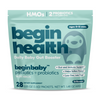HMOs in Formula: Are They the Same as Breast Milk?
share this article

Human milk oligosaccharides (HMOs) have been getting a lot of attention lately and for good reason. These special prebiotics are the third most abundant solid component in breast milk, after lactose and fat. They help feed beneficial bacteria in the baby’s gut, support immune development, and even protect against harmful pathogens.
But as more infant formulas begin to include HMOs like 2’-fucosyllactose (2’-FL), many parents ask: Are the HMOs in formula really the same as those in breast milk? The answer is... not exactly, but they’re getting closer.
Here’s what you need to know.
What Are HMOs?
HMOs are complex carbohydrates unique to human breast milk. More than 200 distinct HMOs have been identified in breast milk, and they vary in structure, function, and abundance. These prebiotic compounds are not digested by the baby, instead, they feed beneficial gut bacteria (especially Bifidobacterium infantis) and help shape a healthy microbiome in early life.
HMOs also act as decoys for harmful bacteria and viruses, preventing them from attaching to the gut lining and reducing infection risk [1].
HMOs in Formula: How Do They Compare?
Infant formula historically did not include HMOs, leaving formula-fed babies without one of the key components that support the early gut. But today, some formulas now include synthetically produced HMOs, most commonly 2’-fucosyllactose (2’-FL).
2’-FL is the most abundant HMO found in human milk. Thanks to advances in biotechnology, companies can now produce a structurally identical version of 2’-FL using safe microbial fermentation. The 2’-FL in formula is chemically and structurally identical to what’s found in breast milk [2].
However, formula only contains one or a few types of HMOs, whereas breast milk contains a diverse mix of over 200. This difference matters because different HMOs support different functions in the infant gut and immune system.
Do HMOs in Formula Work?
The research is promising. Studies show that adding 2’-FL to formula may:
-
Promote growth of beneficial Bifidobacterium species
-
Help reduce the incidence of infections and diarrhea
-
Support immune responses similar to those of breastfed infants
-
Improve gut barrier function and reduce inflammation
In a randomized controlled trial, infants who received formula with 2’-FL had fewer respiratory infections and improved immune markers compared to those who received standard formula [3].
While a single HMO like 2’-FL can’t replicate the full complexity of breast milk, it clearly offers important gut and immune benefits.
Should You Supplement If Your Formula Doesn’t Contain HMOs?
If your baby's formula doesn’t contain HMOs, supplementation may help bridge the gap. Products like Beginbaby Prebiotic + Probiotics provide 2’-FL HMO along with clinically studied probiotic strains like B. infantis and B. lactis.
Together, these ingredients support stool consistency, promote a healthy gut microbiome, and help mimic the beneficial effects of breast milk on digestion and immunity.
Always talk to your pediatrician before starting a supplement, especially with infants under six months.
Summary
HMOs in formula, especially 2’-FL, are structurally identical to those in breast milk and can offer meaningful benefits for gut health and immunity. However, breast milk contains hundreds of HMOs, while formula typically contains just one or two.
For parents looking to support their baby’s gut health, especially when breastfeeding isn’t an option, choosing an HMO-containing formula or a supplement like Beginbaby Prebiotic + Probiotics can be a smart and science-backed step.
















